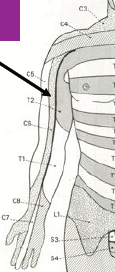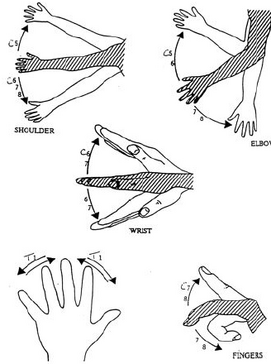Lecture Details[]
Paul McMenamin; Week 5 MED1022; Anatomy
Lecture Content[]
Schlerotome, myotome and dermatome are derived from somites. Nerves grow into mesenchyme. Nerve fibres follow

surface cues (glycoproteins) to enter each myotome. As limb buds grow, nerve distribution is segmented. Some dermatomes lose connection to the trunk, the area where they come together is the axial line which represents the former longitudinal axis of developing limb.
Cutaneous nerves can carry sensory fibres from several segments and contribute to different dermatomes.
Myotome is a component of muscle supplied by one segment of the spinal cord. Each myotome forms a dorsal epimere (back muscle) and ventral hypomere. Myotomes migrate alongside the neural tube. They drag nerve supply with them- is a tell tale sign of origin. Some limb myotomes may contribute to several muscles.
Shared primary action on a joint equals shared nerve supply. Opposite action often is in

numerical sequence to its other. Spinal centres for joint movement tend to occupy continuous segments.
Nerve entrapments can cause thoracic outlet syndrome (T1 problems), suprascapular nerve, elbow has ulnar, median, radial, forearm has median and dorsal branches of radial, wrist has median and ulnar. All these can be trapped.
Angiosomes are areas supplied by a common blood vessel; relevant to myocutaneous flaps.